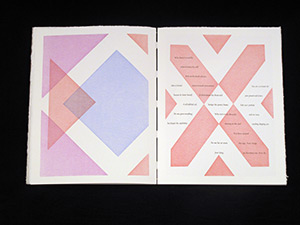Ruminations
– Out of Print –

Since Denison Library at Scripps College and Honnold Library at the Claremont Colleges have significant collections of medieval books, many still in their original bindings, the assignment to study these rare books was the focus of the Typography and the Book Arts class at the Scripps College Press. For the semester book project for undergraduates, the students selected eight books from the 14th to the 15th centuries at Denison for in-depth research into which medieval attributes persist in contemporary artist books. The books presented a range of subjects from Cicero and a law text to graduals, pontificals and books of hours. The students made PowerPoint presentations to each other on the books they studied, highlighting not only physical characteristics but also translation of a short section of the book.
In addition to the obvious physical characteristics in medieval books: vellum, leather over wood boards, calligraphy, illumination and miniatures, the students remarked that the texts that were hand-calligraphed were serious and of vital importance to the makers. In that vein, they decided to search for texts that were important to them to present in their book. Twelve students brought in twelve texts for consideration: poems and excerpts from novels, a family letter found after a fire burned down their house, a job acceptance letter, texts projected into space via the Voyager project, Harry Potter novels. After extensive discussion, the students winnowed down those twelve texts to the final selection of a poem from a 13th century Persian poet, Rumi. As did the medievals, they wrote commentaries on this evocative text, which was interpreted by Coleman Barks, who generously gave us permission to use his poem. The text was presented anew by each student in their section, either the entire poem or a selection, arranging the text and commentary within a structure.
The visual aspects of the book were inspired by the geometric structures of medieval book imagery, which included rectangular storyboarding and non-rectangular narrative structures. The colors of the linoleum blocks reflect the preponderance of lapis lazuli blue, crimson red and royal purple in medieval miniatures. They were printed lightly in order to read the text printed on top. The Ginga Iridescent Orange bookcloth used for the binding introduces gold, which was quite prevalent in medieval manuscripts. The sheets of Rives BFK paper were folded into signatures, which were sewn over Tyvek-reinforced tapes with gold thread and are attached to the covers. The size is 11 x 14 inches; and the book was printed in an edition of 103 copies.
Order a Book from Scripps College Press
If you would like to purchase a copy of the books or broadsides, please send a check, payable to the Scripps College Press, to the address below. Please add California sales tax of 8.75% if book is in stock, and a shipping fee of $12.00 per book.Become a Patron
If you wish to become a standing order patron, you will receive 20% off the list price of the books and will receive each book immediately after it is completed. We complete a collaborative book each semester. Please indicate with your order if you wish to become a subscriber.Scripps College Press 1030 Columbia Ave. #2025 Claremont, CA 91711 Attn: Tia BlassingameIf you would like more information, please call (909) 607-3866.
| Previous: Manu*Script | Next: Ad Libitum |

